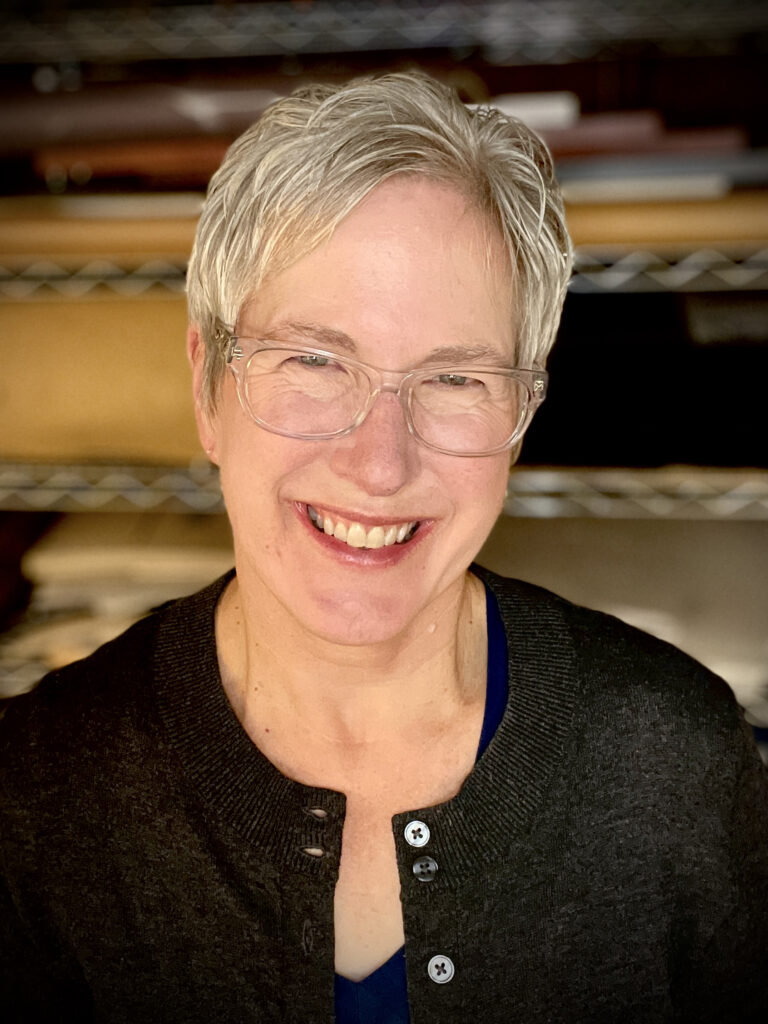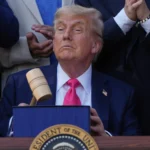WOMEN YOU SHOULD KNOW IN WYOMING: State Selects Five Artists to Watch (PART 1)
Artists nominated for National Museum of Women in the Arts 2024 show
- Published In: Other News & Features
- Last Updated: Sep 27, 2023

Bronwyn Minton is a Jackson artist and the executive director of the Arts Association of Jackson. (Courtesy photo from Bronwyn Minton)
By Elizabeth Sampson
Special to the Wyoming Truth
For five Wyoming women, making art isn’t just about creating something beautiful. It’s also about starting conversations, asking questions and discovering their place in the world.
Jackson’s Tammi Hanawalt, curator of art at the National Museum of Wildlife Art, selected the artists for consideration in the National Museum of Women in the Arts’ (NMWA) exhibit “New Worlds: Women to Watch 2024.”

Though the museum could only select one Wyoming artist for its show in Washington, D.C., all five will have their work promoted by the Wyoming committee of NMWA. This is the first year a Wyoming artist has been featured in the show.
In its Women You Should Know in Wyoming series, the Wyoming Truth is profiling the five artists. First up are Bronwyn Minton and Jennifer Rife.
Bronwyn Minton
Watching the way leaves and branches create flickering shadows in nature inspired one of Bronwyn Minton’s largest art installations. The Jackson artist attached hundreds of pieces of wax paper to beautiful yarn, hanging it along a wall where the paper flutters and casts shadows when someone walks beside it.
“[My art] thinks about movement and shadow and maybe comes out of [my love for] the way all kinds of different things in nature make shadows,” Minton said. “When I was younger, I did a lot more representational kinds of things. It has evolved into more abstract sculptural pieces that imply or reference the natural world.”
Her love of the natural world started early. Minton, 54, grew up in Vermont and New Hampshire, but spent her summers in Maine and heard countless stories about her mother’s youthful adventures working at a Wyoming horse camp. When she offered to send her 10-year-old daughter to the same camp, Minton jumped at the chance and attended for many years. She also went on to run pack trips and work as a counselor, wrangler and cook.

“Wyoming was embedded in me,” she said.
Minton, who earned a BFA from the Rhode Island School of Design and an MFA from the San Francisco Art Institute, moved to Jackson in 1992 after living in New York and Portland, Oregon. She longed for the mountains of Wyoming.
“I needed the space in my mind — and physically the space — to think and have ideas about making things,” she said. “I am a Wyoming artist because the land and the space of Wyoming [are] so important to me.”

Minton has been a curator of the National Museum of Wildlife Art, an art teacher and an exhibiting artist. Today, she is the executive director of the Art Association of Jackson Hole, and her work utilizes everything from print making and film to clay, wood and paper.
“She’s thinking about how her art speaks to things in the natural world—how they change and how changing them can bring about different meanings,” Hanawalt said.
Some of Minton’s art ends up being large—up to 30 feet long by 10 feet tall. In addition to the fluttering wax paper installation, she has prints of pressed leaves on white paper behind plexiglass that stretch across a wall, and she also makes functional pottery and jewelry.
Minton has received the Wyoming Governor’s Arts Award, two Wyoming Arts Council Visual Arts Fellowships and a Wyoming Arts Council Visual Arts Fellowship Honorable mention. Being an artist in Wyoming can be challenging, she said, because supplies aren’t always readily available and have to be shipped in. But the small population means the artist population is small and welcoming.
“It is a giant state, and it takes a really long time to drive across it, but it’s not a very big arts community,” Minton said. “It’s really cool to know I know a bunch of artists all across the state. I can visit with them and connect with them, and it doesn’t feel lonely.”
Jennifer Rife
Jennifer Rife never intends for anyone to see her work in person. She doesn’t know if she will ever sell another piece of art. Instead, Rife has freed herself from the constraints of showing and selling her art, so she can focus on the joy of just making what she sees in her imagination.
As an environmental artist, Rife, 59, of Cheyenne, uses found objects to create temporary sculptural art in open spaces. Rather than encouraging viewers to tromp across the land where her art initially resides, she installs it, takes photographs and then dismantles it—all before anyone, other than her husband, lays eyes on it.

“All that exists of that moment in time are the photographs that I take,” Rife said.
Rife is inspired by land art—that is artists sculpting the land itself using equipment like bulldozers. But she doesn’t want to impact the land in such a huge way with her art.
“Of course, I drive to these places—it’s not like I don’t have a carbon footprint at all,” she said. “I try to leave as little mark on the site where I am working as I possibly can.”
Rife creates her work in her studio, and then takes it with her when she and her husband go on road trips, making stops in state or national parks to photograph her work. When Rife shares her photos, she projects them on a wall or makes small 5×7 prints. The titles of her photos are the geographic coordinates where she shot them.
“I want people to think about what are we putting on the land, how are we using it and what scars are we creating on the land,” Rife said.

The building scraps that make up her work — pipes, wires and plastic — encourage viewers to contemplate what humans erect on the earth.
“She does these sculptures that are completely taken away…then there’s no trace,” Hanawalt said. “You think about mortality, the environment and what it’s become and human influence on the environment. The way she does the photography is really wonderful as well.”
Raised in Lamar, Colorado, Rife earned a BFA from the University of Kansas. She recently retired as the exhibitions coordinator for the Laramie County Library, where she curated rotating art exhibits.
At one point, she created art that was meant to be sold, but it did not give her creative fulfillment.
“What I am doing now does,” Rife said. “I know that art like mine, which tends to be more about an idea and conceptual, can be a real challenge to people who are not familiar with art. It’s OK to say, ‘I don’t get it’ and to have questions. To me, art is more about the questions we ask—and not about the answers.”













